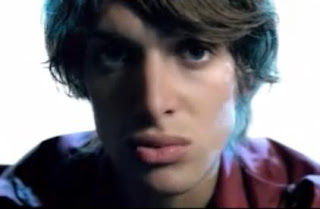- CUs and ECUs of the artist
- Emotive narratives.
- Shots of the artist singing/playing instrument
CU of Paulo Nutini for his video 'Last Request'

ECU of Adele singing for her video 'Hometown Glory
We noticed that these three aspects appeared in so many of the music videos that we watched for preparation and research, that they were key aspects, and so we tried to include as much of these as possible within our video.
CU of Ben playing guitar

With reference to Goodwin's critical theory framework, we created an illustrative video as the song was written by James Morrison explaining how he had a hard upbringing as a child and felt alone and so we thought this would be the best method to take. To illustrate the song to the audience, our narrative consists of both the older character, Ben, and the younger character, Thomas, in a park with shots of Thomas often being alone in a crowded play area, and Ben sitting in the same places.
Footage of a transition between the two characters sitting in the same place
We amplified the lyrics, mainly through having the artist miming and playing the music, and the guitar also amplifies the sound throughout the video, as the audience will be paying more attention to the music with that footage. There is often a first person mode of address, as Ben is seen to sing the words whilst looking into the camera, as if to tell his story to the audience, this also gives a sense of para-social intimacy.
Footage of Ben singing to the camera - first person mode of address
The main aspect of Goodwin that is frequent is the relationship between visuals and lyrics, as the visual images are directly taken from the song, amplifying it and creating a real narrative for the audience to try and understand, which then makes it stand to repeated viewings.
We decided to shoot all of the footage within the same location, as we thought it was the most suitable location for the music video, but it also kept a sense of recognition and flowing throughout the video, linking the two characters and the narrative together. Although the performance footage is done in a different area of the park, it is still in a peaceful area, creating a relaxing setting and fitting the acoustic feel to the song.
Footage of Ben performing in the park.
There are a variety of signifiers throughout the video, that we tried to incorporate to signify to the audience the meaning of the song, but also to tell them about the artist. As both the digipak and advert designs, and the video are all set in the park location, this immediately signifies a more relaxed sounding music. It is set in an organic location, natural surroundings, with connotes an acoustic sound, which is similar to James Morrison's music.
- Young boy looking to the camera smiling as playing guitar, showed in the shots below - connotes he has found something he enjoys, this follows through as he becomes the musician, music helps him cope.

- The playground connotes a time of innocence and childhood fun but this is challenged by the narrative having Thomas looking lost and lonely.
- CU of the young boy looking around - connotes he is looking for someone, as shown in the shots below.

- The two characters are wearing a similar outfit - connotes they are the same person but at different ages. This is also evident through the footage of them both playing the guitar.
- Sunny/warm weather when the older character is performing, as shown in the shots below, - connotes that he has moved on and is in a happier time, and forgiven his father.









 I thought the following comment was particularly interesting as this could definitely be a reading of the text but would not be a reading of the lyrics.
I thought the following comment was particularly interesting as this could definitely be a reading of the text but would not be a reading of the lyrics.

 This is an example of Web 2.0 as it allows our group to interact with each other through the blog. The blog is also another example of Web 2.0 as it allows us to post images and videos up to the blog, from our own sources or from the Internet. We posted images up to the blog, but also video clips for the early stages of research when we were analysing music videos.
This is an example of Web 2.0 as it allows our group to interact with each other through the blog. The blog is also another example of Web 2.0 as it allows us to post images and videos up to the blog, from our own sources or from the Internet. We posted images up to the blog, but also video clips for the early stages of research when we were analysing music videos.








